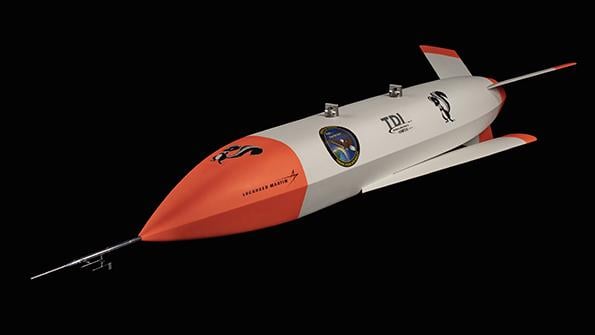
Lockheed Martin’s Skunk Works has taken the wraps off an experimental, air-launched unmanned aircraft system called Speed Racer that is meant to validate a new manufacturing process as much as a possible new weapon system.
A company-produced video released on the eve of the virtual Aerospace Warfare Symposium that ran Feb. 24-26 reveals a small, jet-powered unmanned aircraft system (UAS) with a hexagonal fuselage, folding and swept wings, plus two sharply canted aft dorsal tails, along with one ventral tail.
- Speed Racer is close to first flight
- Skunk Works trademarks StarDrive
The unidentified UAS in the video is launched by a twin-engine aircraft that strongly resembles a Beechcraft 1900D, although the launch platform choice in the video may be arbitrary. During the launch sequence, the UAS is released from a wing store. An exhaust plug is ejected as the engine starts, and the wings fold out to provide lift. As the UAS cruises low over a rocky landscape, no hint of a specific mission is shown.
Reflecting the new trend of military design that blurs the line between a reconnaissance-gathering UAS and a target-seeking cruise missile, either a sensor payload or a warhead may be on board.
Asked to confirm the identity of the UAS, a Lockheed Martin spokeswoman verified that the video quietly reveals the aircraft at the center of the secretive Speed Racer program. The video shows a “configuration our team continues to explore for Speed Racer,” the spokeswoman added.
The existence of Speed Racer became known only five months ago during a lightly attended online press event by the Skunk Works at the virtual Air, Space and Cyber Conference. At the time, Lockheed Program Manager Joe Pokora acknowledged only that the letters of Speed Racer spell out an acronym, but he declined to elaborate on the details.
Despite sharing the name of an American version of a Japanese cartoon series about a car called the Mach 5, the first term of Lockheed’s Speed Racer concept may not actually imply anything about the velocity of the vehicle. The name instead reflects the Skunk Works’ embrace of the digital engineering ethos for aircraft design now championed by the U.S. Air Force.
On Feb. 11, Lockheed received U.S. government approval to adopt a new trademark for StarDrive. Reminiscent of Boeing’s branded “Black Diamond” project to support the manufacturing process for a failed joint bid with Lockheed for the Long-Range Strike Bomber contract, StarDrive is Lockheed’s name for a new digital engineering process.
Engineers have used digital tools for decades, but this new approach is far more inclusive, says Renee Pasman, Skunk Works director of integrated systems. One of the main challenges of the past was coordinating projects’ various engineering disciplines. Lockheed’s approach to digital engineering now seeks to bring together engineering with production, the supply chain, finance and sustainment at the beginning of a new design.
“That partnership, not just from an engineering perspective, but from all of the functions involved, is going to be key,” Pasman says.
“We are working in partnership between us and the government on how to make significant progress there,” Pasman adds. “And it is a very exciting thing that’s coming up here in the next couple of months [and] years, as we work through some of this and get that capability out.”
A new artifact of the StarDrive process is an advanced new manufacturing process, which produced a prototype of a full-size hole with determinate assembly for composite airframe skins, the company says. In determinate assembly, holes are drilled so precisely that they can be used to align components without a costly jig or tool involved.
Any involvement by the Air Force in the Speed Racer program at this point is unknown, but there are clear signs of interest. The Armament Industry Roundtable scheduled by the Air Force Research Laboratory in late March advertises that topics of discussion will include Speed Racer, which is listed alongside two Air Force-funded projects—Golden Horde and Gray Wolf—that seek to introduce more autonomous capabilities in low-cost cruise missiles and other weapons.
A common supplier for Gray Wolf and Speed Racer is Kratos Turbine Technologies (KTT), a division that specializes in low-cost turbojets. Technical Directions Inc., a KTT subsidiary, delivered the engines for the Speed Racer program earlier this month.






Comments
"A new artifact of the StarDrive process is an advanced new manufacturing process, which produced a prototype of a full-size hole with determinate assembly for composite airframe skins, the company says. In determinate assembly, holes are drilled so precisely that they can be used to align components without a costly jig or tool involved."
Determinate assembly using precision-drilled locator holes in order to get rid of heavy tooling for parts alignments is aerospace industry practice since the 1990s.
So what is the advanced part here?